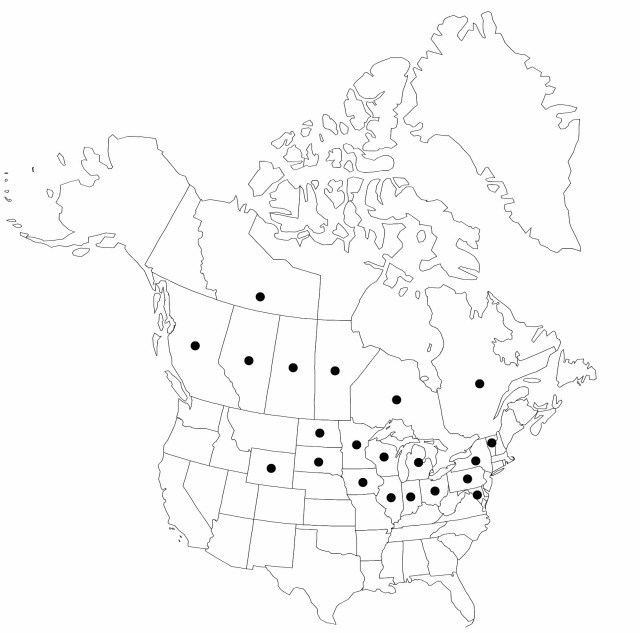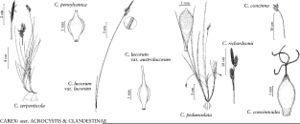Difference between revisions of "Carex richardsonii"
in J. Franklin et al., Narr. Journey Polar Sea, 751. 1823.
FNA>Volume Importer |
FNA>Volume Importer |
(No difference)
| |
Revision as of 21:05, 16 December 2019
Plants loosely cespitose, long-rhizomatous. Culms 14–32 cm. Leaves: basal sheaths dark purplish to reddish brown; blades mostly basal, pale green, shorter than culms, thick, 0.9–3.3 mm wide. Inflorescences: peduncles of proximal pistillate spikes to 7 cm; peduncles of terminal staminate spikes 3.3–15.7 mm; proximal bracts long-sheathing; pistillate spikes 2–4, emerging from cauline nodes, widely separated, ascending, ovoid to ellipsoid or short-cylindric; terminal staminate spikes 17.4–23 × 2.5–3.8 mm. Scales: pistillate scales reddish brown, ovate, apex acute to obtuse, glabrous; staminate scales reddish brown, ovate to obovate, margins silvery-white, apex acute to short-acuminate, scarious. Anthers 2.1–2.6 mm. Perigynia obovoid to oblanceoloid, 2.4–2.9 × 1–1.3 mm, base tapering, pubescent with straight white hairs; beak straight, 0.2–0.5 mm. Stigmas 3, flexuous, thin, strongly papillose. Achenes ellipsoid to obovoid, 1.7–1.8 × 1.1–1.2 mm. 2n = 52.
Phenology: Fruiting late spring–summer (late May–mid Jul).
Habitat: Vernally moist (often drying later in the season), open woodlands, alvars, floodplain edges, prairies, and basic and acidic outcrops
Elevation: 50–1400 m
Distribution

Alta., B.C., Man., N.W.T., Ont., Que., Sask., Ill., Ind., Iowa, Md., Mich., Minn., N.Y., N.Dak., Ohio, Pa., S.Dak., Vt., Wis., Wyo.
Discussion
Carex richardsonii is common on the Canadian prairies and in open montane woodlands east of the Cascades. Farther east, it is a rare plant of alvars, tall-grass prairie remnants, and postglacial shorelines, such as those of Lake Iroquois (in Ontario and New York) and Lake Barlow-Ojibway (in Quebec). It is most closely related to, and perhaps the ancestor of, C. concinnoides. Chromosomal data and phylogenetic analysis may help to test that contention.
The long, dark reddish brown sheaths are a conspicuous field mark. Late in the growing season, the leaves often turn dark wine red. This species tends to have low seed set.
Selected References
None.
